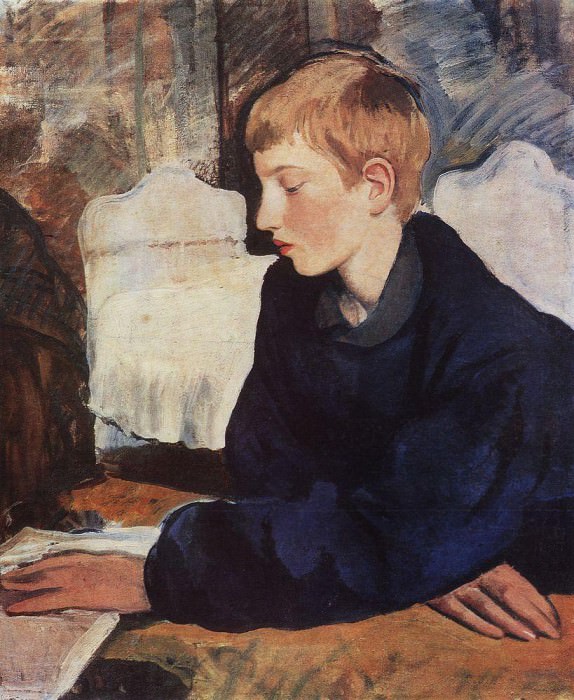Zhenya Portrait of a painter s son Zinaida Serebryakova (1884-1967)
Zinaida Serebryakova – Zhenya Portrait of a painter s son
Edit attribution
Download full size: 819×1000 px (0,1 Mb)
Painter: Zinaida Serebryakova
Zinaida Serebryakova was born in the village of Neskuchny, Kharkov Province, in the family of the famous architects and artists Lencere-Benoit. The girl inherited a bright creative talent of the family and after graduating from high school she goes to Italy for an apprenticeship, studying painting at the academy in Paris. In 1905, Zinaida marries Boris Serebryakov, to whom she has four children in a happy marriage.
Description of the painting "Portrait of Zhenya" by Zinaida Serebryakova
Zinaida Serebryakova was born in the village of Neskuchny, Kharkov Province, in the family of the famous architects and artists Lencere-Benoit. The girl inherited a bright creative talent of the family and after graduating from high school she goes to Italy for an apprenticeship, studying painting at the academy in Paris.
In 1905, Zinaida marries Boris Serebryakov, to whom she has four children in a happy marriage. The family lives in St. Petersburg, in the summertime going to the family estate in Neskuchnoye. In the Serebryakov house there is harmony, spiritual warmth, love, respectful and careful treatment of each other.
In these happy years Zinaida works a lot and hard. Her formation as a personality and artist, under the influence of the general mood in the creative environment on the search for humanistic ideals, great and heroic images, has resulted in dozens of wonderful paintings, filled with kindness and joy, colorful landscapes, sunny images of simple peasant women and children.
One of her most famous works is the self-portrait "Behind the Toilet", where the artist depicts herself in front of the mirror, smiling carefree and combing her hair. At the same time, she painted many compositions and portraits of her children. The two older sons Evgeny and Alexander and the younger girls Tata and Katya with their lovely faces, with infinite love and tenderness performed by the talented mother, illuminate the most ordinary scenes of daily life - tea parties on the terrace, preparing lunch, waiting for breakfast, playing the piano. Everything in these pictures breathes with the happiness and hospitality of a large friendly home, and no one knows yet how tragically their fate will develop.
The revolution caught Serebryakov in Kharkov. In 1919 Zinaida’s husband suddenly dies, infected with typhus, and she is left with children and an old mother without money and work. Looking for a way out, the Serebryakovs leave for Petrograd, then Zinaida goes to Paris to organize an exhibition. However, the Soviet Russia lowers the iron curtain and her return home becomes impossible. Her relatives and friends hardly manage to take two of her four children, Sasha and Katya, to Paris, Zinaida will see her other children, Evgenie and Tatiana, only 36 years later.
Zinaida Serebryakova painted a portrait of Zhenya, her elder son, in 1917. As if anticipating an impending separation, the artist has depicted the boy in her unusual for her restrained, even gloomy colors, not focusing on the details of the interior and surroundings. The boy is depicted in profile and does not look at the viewer. His hands are not engaged in anything, he looks thoughtfully and idly at the book open in front of him. Apart from the simple white bed in the background, there is nothing else in the painting.
The times do not choose...
Кому понравилось
Пожалуйста, подождите
На эту операцию может потребоваться несколько секунд.
Информация появится в новом окне,
если открытие новых окон не запрещено в настройках вашего браузера.
You need to login
Для работы с коллекциями – пожалуйста, войдите в аккаунт (open in new window).




















You cannot comment Why?
Perhaps it’s a painting of a boy sitting at a table with a book in his hand and a pen in his other hand.